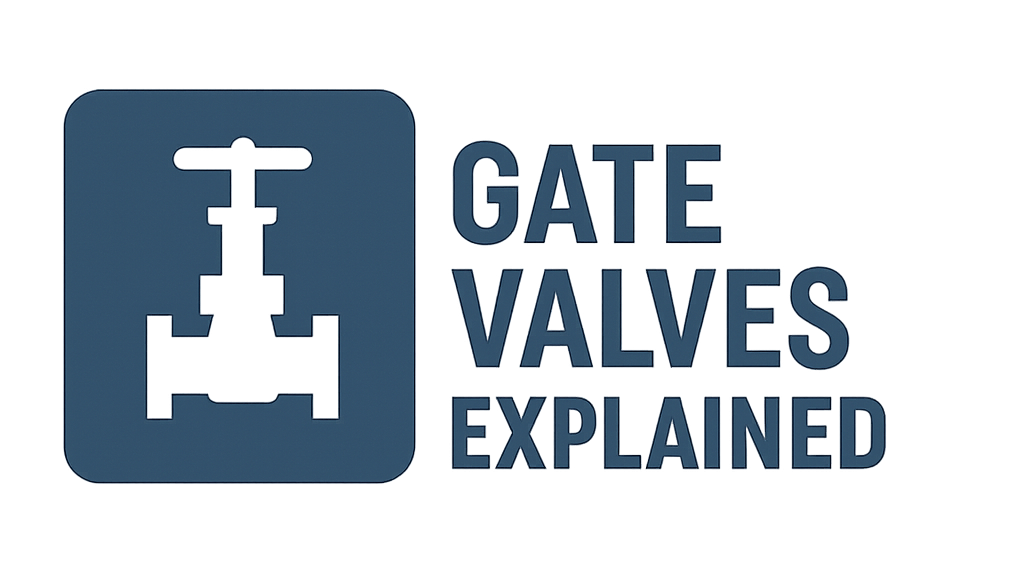Gate Valves Explained
Understanding Design, Operation, and Applications
Introduction to Gate Valves
Gate valves are multi-turn valves designed primarily for on/off (isolation) service. They operate by lifting a rectangular or wedge-shaped gate out of the path of the fluid. When fully open, gate valves offer minimal flow restriction, making them ideal for applications where a straight-line flow of fluid and minimum pressure drop are desired. They are widely used in various industries for their reliability in fully open or fully closed positions.
Working Principle: Linear Motion Control
The operation of a gate valve involves linear motion of the gate:
- Linear Actuation: Turning the handwheel (or actuator) rotates the stem, which is threaded into the gate.
- Gate Movement:
- To OPEN the valve, the handwheel is turned counter-clockwise, lifting the gate out of the flow path.
- To CLOSE the valve, the handwheel is turned clockwise, lowering the gate to seal against the valve seats.
- Sealing: Achieved by the tight contact between the gate’s sealing surfaces and the seat rings in the valve body when the valve is fully closed.
Gate valves are not recommended for throttling or regulating flow, as partial opening can cause vibration and erosion of the gate and seats.
CLOSED
OPEN
Key Components of a Gate Valve
Valve Body
The primary pressure-containing part, housing internal components and connecting to the pipeline.
Bonnet
Covers the valve body, houses the stem and packing, and is typically bolted or screwed to the body.
Gate (Disc)
The closure element that moves perpendicular to the flow to open or close the valve. Can be wedge-shaped or a parallel slab/disc.
Stem
Connects the handwheel/actuator to the gate, transmitting force to move the gate. Can be rising or non-rising.
Seat Rings
Provide the sealing surface within the body against which the gate closes. Can be integral or renewable.
Handwheel/Actuator
The mechanism for operating the valve. Handwheel for manual operation; actuators for automated control.
Packing
Seals the area between the stem and bonnet to prevent leakage to the atmosphere. Compressed by a gland.
Main Types of Gate Valves
Based on Gate Design:
Based on Stem Design:
Based on Bonnet Design:
Actuation Methods
Gate valves require multi-turn actuation:
Manual (Handwheel)
Most common for all sizes, though larger valves may require significant effort or impact handwheels.
Electric Actuator
Uses an electric motor and gearbox for automated or remote operation. Common in process plants.
Pneumatic Actuator
Uses compressed air, often with a linear piston or diaphragm actuator. Can provide fast operation.
Hydraulic Actuator
Uses hydraulic fluid for high thrust requirements, suitable for very large or high-pressure valves.
Advantages & Disadvantages
Advantages
- Excellent for on/off (isolation) service.
- Minimal pressure drop when fully open.
- Good sealing capability (bi-directional for some designs).
- Relatively simple design and construction.
- Can be used with a wide variety of fluids, including slurries.
- Available in large sizes and high-pressure ratings.
Disadvantages
- Poor throttling characteristics; not suitable for flow regulation.
- Slow operation due to multi-turn actuation.
- Prone to seat and disc erosion if used for throttling.
- Can be bulky and heavy, especially in larger sizes.
- Vibration can occur when partially open.
- Susceptible to thermal binding in high-temperature applications if not properly designed (e.g., flexible wedge).
Common Materials of Construction
Body & Bonnet
- Cast Iron (e.g., ASTM A126 Class B) – for low pressure water, air.
- Ductile Iron (e.g., ASTM A536) – higher strength than cast iron.
- Carbon Steel (e.g., ASTM A216 WCB, A105) – general industrial.
- Stainless Steel (e.g., ASTM A351 CF8M/316, CF8/304) – corrosive service.
- Alloy Steels (e.g., ASTM A217 WC6, WC9, C5, C12) – high temperature.
- Bronze, Brass – for specific chemical compatibility or marine use.
Trim (Gate, Stem, Seat Rings)
- Stainless Steel (e.g., 304, 316, 410) – common for corrosion/erosion resistance.
- Stellite® (Cobalt-Chromium alloy) – hardfacing for severe service, high temperature, erosion.
- Monel® – for corrosive environments like seawater, hydrofluoric acid.
- Bronze – for some lower pressure applications.
- Alloy 20 – for highly corrosive applications.
Typical Applications
Gate valves are workhorses in many industries:
Key Selection Considerations
- Service Type: Primarily for on/off isolation.
- Fluid Properties: Corrosiveness, temperature, pressure, presence of solids.
- Operating Pressure & Temperature: Determines material and pressure class.
- Frequency of Operation: Less suitable for frequent cycling compared to quarter-turn valves.
- Space Limitations: Rising stem valves require more headroom.
- Flow Restriction: Minimal when fully open.
- Material Compatibility: Body and trim materials must be compatible with the process fluid.
- Industry Standards: Compliance with API, ASME, ISO standards.
- Cost: Gate valves can be more expensive than ball valves in smaller sizes but may be more economical in very large sizes.
- Maintenance: Bolted bonnets allow for easier maintenance than welded bonnets.
Gate Valve vs. Ball Valve (Brief Comparison)
| Feature | Gate Valve | Ball Valve |
|---|---|---|
| Operation | Multi-turn (Linear) | Quarter-turn (Rotary) |
| Primary Use | On/Off (Isolation) | On/Off (Can be used for throttling with V-port) |
| Flow Restriction (Open) | Very Low | Low (Full Port) to Moderate (Reduced Port) |
| Sealing | Good, can be bi-directional | Excellent, typically bubble-tight |
| Throttling | Poor | Fair (with V-port), otherwise poor |
| Size/Weight | Can be bulky/heavy | More compact/lighter |
Reliable Isolation for Demanding Services
Gate valves have long been a staple in fluid handling systems for their robust design and effective shutoff capabilities, especially in applications requiring minimal flow restriction. While not suited for throttling, their performance in fully open or fully closed positions makes them indispensable in many industrial processes. Understanding their various designs, materials, and operational characteristics is crucial for selecting the right gate valve for safe and efficient system performance.

